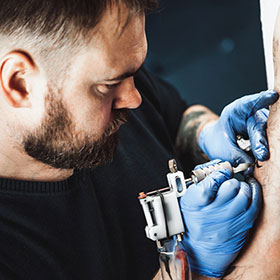Yes, sleeve tattoos can hurt. Pain levels vary by person and placement.
Tattooing involves needles piercing the skin. So, some discomfort is normal. The pain can range from mild to intense, depending on your pain tolerance and the tattoo’s location. Areas with more bone or nerve endings tend to hurt more. While some people describe the sensation as a slight irritation, others might find it more painful.
Remember, pain is subjective. What feels like a minor sting to one person can feel much worse to another. Understanding this can help set your expectations. In this blog, we’ll explore factors that affect tattoo pain, tips to manage it, and what you can do to make the process smoother. Keep reading to learn more about what to expect with sleeve tattoos.
Introduction To Sleeve Tattoos
A sleeve tattoo covers the arm from the shoulder to the wrist. This type of tattoo is like a long sleeve of a shirt. It can have many designs and colors. Each sleeve is unique. Some people choose a theme for their sleeve. Others mix different designs. The art can be simple or very detailed. Getting a sleeve tattoo takes time. It can take many sessions to complete.
Sleeve tattoos are very popular now. Many people like how they look. Celebrities have sleeve tattoos. This makes them even more trendy. New styles appear all the time. Watercolor and geometric designs are in trend. Black and grey tattoos are also popular. People like to express themselves with tattoos. They tell their stories through art on their skin.
Pain Factors
Pain tolerance varies from person to person. Some people feel more pain than others. Mental state also affects pain. Being calm can reduce pain. Sleep and rest help in feeling less pain. Stress can make pain feel worse. Eating well can help too.
Tattoo placement affects pain levels. Areas with more nerves hurt more. Bony areas also hurt a lot. The inner arm and wrist are sensitive. The shoulder and outer arm hurt less. Fleshy areas are less painful. Hands and feet hurt a lot too.
Pain Levels In Different Areas
The upper arm is a popular spot for sleeve tattoos. The skin here is thicker. It usually hurts less. Many people say it feels like a dull ache. Some spots may be more sensitive. But overall, it is more bearable.
The forearm has more nerve endings. This can make it more painful. The inner part of the forearm is softer. It may hurt more. The outer part is less sensitive. Many people find it more comfortable.
The elbow and wrist are trickier spots. The skin here is thin. There are many bones and nerves. This can make it very painful. Tattoos on the elbow may hurt a lot. The wrist can be sensitive too. Many say it feels like a sharp pain.
Tattooing Process
The first step is the initial consultation. Here, you meet the artist. You discuss your ideas and preferences. The artist gives advice and suggests designs. This meeting helps both of you understand the plan.
Next is the design and planning phase. The artist draws the design. You approve or make changes. The artist then decides the tattoo placement. This step is crucial for a good result.
The final step is the tattoo session. The artist cleans the skin first. Then, they apply the stencil. The tattooing starts with an outline. After that, they fill in the details. This process can take many hours or even days.
Managing Pain
Applying a numbing cream can reduce the pain. You can also take breaks during the session. Ask the artist to pause if it hurts too much. Drinking water helps keep your skin healthy. Healthy skin feels less pain. Listening to music can distract you. Bring headphones for your session. Deep breathing also helps manage pain. Slow breaths can calm your nerves.
Prepare your mind for the pain. Think of it as a journey. Stay positive and calm. Focus on the end result. Remember why you want the tattoo. Visualize the finished artwork. It helps to know the pain is temporary. Keep reminding yourself it will pass soon. Speaking to others with tattoos can help too. They can share their experiences and tips.
Aftercare And Healing
Keep the tattoo clean and dry. Use a mild soap to wash it. Pat it dry gently with a clean towel. Apply a thin layer of healing ointment. Do this for the first few days. Avoid direct sunlight. Do not scratch or pick at the tattoo.
Moisturize the tattoo daily. Use a fragrance-free lotion. Stay out of the sun. If you need to be outside, cover the tattoo. Avoid soaking the tattoo in water. This means no swimming or hot tubs. Follow these steps for at least two weeks. Your tattoo will heal better and look its best.
Personal Experiences
Many people have shared their stories. Some said it hurts a lot. Others felt little pain. It depends on the area. The inner arm is more sensitive. The outer arm hurts less. Pain tolerance varies. Some people even enjoyed the process.
Tattoo artists have a lot to say. Most agree that pain differs for everyone. The skill of the artist matters. A gentle touch can reduce pain. They use numbing creams sometimes. This helps with the discomfort. The design and size also play a role. Larger tattoos can take longer. This might increase the pain. But, many find the result worth it.
Conclusion
Sleeve tattoos can be painful, but the experience varies. Pain tolerance differs for everyone. Some areas hurt more than others. Proper aftercare helps manage discomfort. Consult with your tattoo artist. They can offer helpful tips. Prepare yourself mentally and physically.
Stay hydrated and well-rested. Remember, the result is worth it. Your sleeve tattoo will look amazing. Embrace the journey and enjoy your new art.

